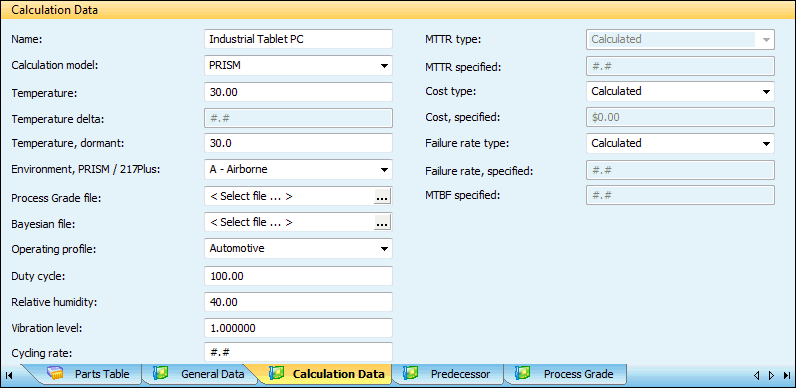Calculation Data for 217Plus Parts Stress or PRISM Model
The following form is shown in the Calculation Data pane when the 217Plus Parts Stress or PRISM model is either inherited or selected for Calculation model.

The following table describes the data fields in the Calculation Data pane for the 217Plus Parts Stress or PRISM model. Field availability depends on selections made in various fields.
Field | Description | ||
|---|---|---|---|
Name | The name assigned to the assembly in the System Tree Items table. | ||
Calculation model | The reliability prediction standard or model to use to compute the predicted failure rate of the assembly. Choices include all licensed models. As described in Model Selection, a lower-level assembly inherits the model selected for its parent assembly, but when the 217 Plus Parts Stress or PRISM model is selected, you can specify an override model, which its child items also inherit. | ||
Temperature | The operating temperature of the assembly in degrees C. For more information, see Operating Temperature. | ||
Temperature delta | A temperature adjustment value in degrees C. This value is added to the operating temperature to get the ambient/environment/case temperature, depending on which is appropriate for the model selected. While this field is unavailable for the top-most assembly (system), it is available for all lower-level assemblies. | ||
Temperature, dormant | The outside ambient temperature when the assembly is dormant. The default value is based on the selection for Environment, PRISM / 217Plus. | ||
Environment, PRISM / 217Plus | The surroundings in which the assembly operates. The environments for the 217Plus and PRISM models are listed in 217 Plus Parts Stress and PRISM Environments. The environment that you select determines the default values for the following fields: Temperature, dormant Relative humidity, and Vibration level. If you later select a different environment, the values in the above fields are replaced with the default values associated with this new environment. | ||
Process Grade file | The Prediction Process Grade file to use to adjust the base failure rate of the assembly. You can use this field’s browse button to navigate to and select the file. If a Prediction Process Grade file is not specified, the default Process Grade file is used. For more information, see Prediction Process Grade Files. Optionally, you can select a Prediction Process Grade file in the Process Grade pane. For more information, see Process Grade Pane.
| ||
Bayesian file | The Prediction Bayesian file that contains field and/or test data to take into account in the prediction. You can use this field’s browse button to navigate to and select the file. For more information, see Prediction Bayesian Files. | ||
Operating profile | The operating profile for the assembly. The profile selected for the top-most assembly is inherited by lower-level assemblies in the same way as the model. The profile that you select determines the default values for Duty cycle and Cycling rate. If you later select a different profile, the default values associated with this new profile for Duty cycle and Cycling rate replace those that were previously entered. | ||
Duty cycle | The percentage of time that the assembly is in an active state. The default value is based on the selection for Operating profile. | ||
Relative humidity | The relative humidity in which the assembly operates. The range is between 0 and 100. The default value is based on the selection for Environment, PRISM/ 217Plus. | ||
Vibration level | The vibration level (GRMS) of the assembly. The default value is based on the selection for Environment, PRISM/ 217Plus. | ||
Cycling rate | The number of times that the assembly is turned on/off during a year (cycles/year). The cycling rate affects the cycling portion of the PRISM part failure rate calculation. The more times an assembly cycles on and off, the higher its cycling failure rate. The default value is based on the selection for Operating profile. |
The subsequent fields specify whether assembly results are calculated or specified. For more information, see Calculation Data for Specifying Whether Assembly Results are Calculated or Specified. |